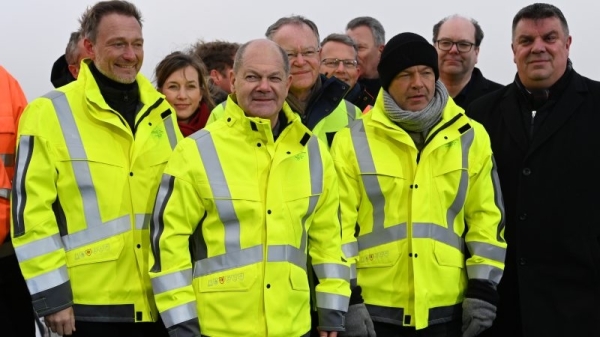Is Germany’s LNG gold rush coming to an end?

Germany’s plan to build at least eight new liquified gas terminals to replace Russian imports are being questioned by a leaked internal analysis for the country’s economy and climate ministry.
Reliance on cheap pipeline gas from Russia is the main reason why liquefied natural gas (LNG) terminals were never built in Germany.
So when Moscow began tightening the noose in 2021, municipalities and developers entered into a frenzy.
Less than ten days after Russian troops began their assault on Ukraine, Germany got “serious about energy independence.” Jörg Kukies, the right-hand man of the Chancellor, announced that the government would fund an LNG terminal in Brunsbüttel – a German first.
In the months that followed, the government would contract another five floating LNG terminals – ships that can regasify the liquid fuel after docking.
From Hamburg to Lubmin, the town where the Russian-backed Nord Stream 1 pipeline resurfaces on German soil, ambitions for building new LNG terminals were rife. Investors envisioned a world with around ten LNG terminals to replace Russian imports.
Germany’s LNG acceleration law, adopted in October 2022, confirmed these ambitions and laid the foundations for the construction of eight floating terminals as well as four permanent onshore terminals.
The floating terminals alone were expected to be large enough to replace the 45 billion cubic metres (bcm) of gas that once flowed directly from Russia. The permanent ones, meanwhile, would provide a similar import capacity.
But today, these ambitions are increasingly being questioned.
According to a leaked internal analysis undertaken for the German ministry of economy and climate action, a majority of planned LNG terminals may in fact not be needed at all.
The analysis “clearly shows that the German government is planning massive LNG overcapacity,” said Sascha Müller-Kraenner, CEO of Environmental Action Germany, who leaked the analysis.
“The two fixed terminals in Stade and Wilhelmshaven and the mega-terminal off Rügen are already no longer included in the considerations,” the environmental activist pointed out.
“In no demand scenario does the expansion of regasification capacities go beyond projects that have FID [Final Investment Decision] status as things stand today,” adds the leaked analysis by the Economic Energy Institute (EWI).
According to the analysis, the planned new LNG terminals would run at below 50% capacity by 2030, assuming the government’s climate and energy saving policies are implemented.
To this day, Germany is still a major consumer of gas, with some 85 bcm imported in 2022. The country had previously “bet” on gas heating “in practically every second household in the past,” admitted Klaus Müller, the head of the federal grid regulator.
However, these assumptions are now being upended by high gas prices, which have triggered a massive energy conservation and diversification effort.
Gas demand is set to drop steadily in the coming years as Germany works to exit Russian fossil fuels and become climate neutral by 2045. Last year, the federal government initiated a push for the massive deployment of heat pumps and home renovation to replace gas boilers.
As a result, Germany’s annual gas demand is expected to fall below 60 bcm by 2030, a far cry from today’s 85 bcm.
These projections have a dampening effect on LNG investments. To this date, Germany’s onshore terminal in Brunsbüttel remains the only permanent one built so far, with clear financial backers.

Germany’s first LNG terminal is open for business
Deprived of cheap Russian gas, Germany’s alternative infrastructure to import liquefied natural gas (LNG) is now coming online, opening a new era in German energy policy.
Planning for the worst
On 19 February, German gas stocks increased for the first time in 2023. With stores sitting comfortably at 70%, talk of LNG overcapacity risked missing the bigger picture, Müller told radio DLF.
“Of course, in mild winters it may seem like you don’t need everything,” he said. But cold winters would not only affect Germany, but much of Central Europe. “The moment we have a cold winter,” neighbouring countries may rely on gas flows from Germany.
Müller identified three risk factors that could cause gas shortages in the future: a “very cold” winter, insufficient gas savings, or “potential issues in neighbouring countries” like Austria.
Much of this will depend on the weather, Müller conceded. Should the coming winter be “very mild” once more, the German government would be forced to “admit that we had redundant infrastructure,” he said.
But should worst-case scenarios materialise, German consumers will need a back-up solution.
“If the next winter is very cold, then suddenly everyone will be very happy that Germany has this [potentially redundant] infrastructure. No one will ask any more whether there was redundant infrastructure,” he said.

Twice as expensive: The high cost of Germany’s floating LNG terminals
Desperate to reduce its reliance on Russian gas, Germany’s speedy construction of infrastructure and leasing of floating LNG terminals may cost much more than initially assumed, Spiegel reported.



